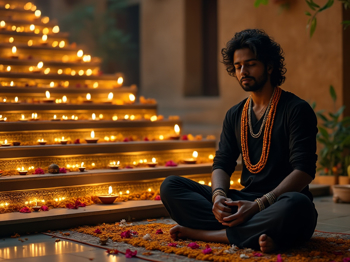The Ayyappa Deeksha Puja holds profound spiritual significance for devotees. It is a time of self-purification and discipline, where the devotee embodies the values of humility, devotion, and simplicity. The Deeksha is believed to cleanse the mind and soul, bringing the devotee closer to the divine. It signifies the journey from ignorance to knowledge, from materialism to spiritualism, and from the physical to the metaphysical. By undertaking the Deeksha, devotees symbolically shed their ego and embrace a life of service, selflessness, and devotion, which culminates in the pilgrimage to Sabarimala.
- Spiritual Growth: The Deeksha encourages deep spiritual reflection, fostering a closer connection with the divine.
- Discipline and Self-Control: Observing the Deeksha requires strict discipline, helping devotees cultivate self-control and mental fortitude.
- Purification of Mind and Body: The rituals and fasting involved in the Deeksha purify both mind and body, leading to overall well-being.
- Increased Devotion: The period of Deeksha deepens the devotee’s faith and devotion, enhancing their spiritual practices.
- Sense of Community: The collective observance of Deeksha among devotees fosters a strong sense of community and shared spiritual purpose.
- Inner Peace and Contentment: The spiritual practices and lifestyle changes during the Deeksha lead to inner peace and a sense of contentment.
- Preparation for Pilgrimage: The Deeksha prepares devotees physically, mentally, and spiritually for the challenging pilgrimage to Sabarimala, ensuring a fulfilling and transformative experience.
Ayyappa Deeksha is not just a religious observance but a transformative journey that brings devotees closer to spiritual enlightenment and the divine presence of Lord Ayyappa.
Step-by-Step Procedure to Perform Ayyappa Deeksha
Observing Ayyappa Deeksha is a sacred process that requires dedication and adherence to specific rituals. Here’s a step-by-step guide to performing Ayyappa Deeksha:
1. Consultation with a Guru
- Find a Guru: Before beginning the Deeksha, it is essential to consult with a Guru (spiritual guide) who has experience in Ayyappa Deeksha. The Guru will provide guidance on the rituals, practices, and significance of the Deeksha.
- Seek Permission: Get the Guru’s blessing and permission to take up the Deeksha. The Guru will help prepare you mentally and spiritually for the journey.
2. Choosing an Auspicious Day
- Select the Start Date: The Deeksha usually begins on an auspicious day, preferably during the Mandala season, which starts in mid-November and ends in mid-January.
- Early Morning Ritual: On the chosen day, perform a head bath early in the morning and wear clean, simple clothes.
3. Wearing the Mala (Sacred Bead Necklace)
- Receive the Mala from the Guru: The Guru will give you a Rudraksha or Tulasi Mala, which symbolizes your vow to observe the Deeksha.
- Wear the Mala: After a small puja (ritual), the Mala is placed around your neck by the Guru. This marks the official beginning of your Deeksha.
4. Observance of Strict Rituals and Discipline
- Daily Puja and Meditation: Perform puja to Lord Ayyappa every morning and evening. Offer prayers, chant Ayyappa mantras, and meditate.
- Fasting and Diet: Follow a simple vegetarian diet, abstaining from meat, alcohol, and other indulgences. Some devotees observe complete fasting on specific days.
- Abstinence: Refrain from smoking, consuming alcohol, and engaging in any form of entertainment or luxury.
- Celibacy: Maintain celibacy during the Deeksha period as a form of self-purification.
5. Maintaining Simplicity and Humility
- Dress Code: Wear only simple, black or saffron-colored clothes during the Deeksha period, symbolizing renunciation and humility.
- Walking Barefoot: Many devotees choose to walk barefoot during this period as a form of penance and to remain connected to the earth.
6. Avoiding Worldly Pleasures
- Live a Simple Life: Avoid worldly pleasures and focus on spiritual practices. Engage in acts of charity and selfless service.
- No Shaving or Haircuts: Devotees do not shave or cut their hair during the Deeksha period as a mark of austerity.
7. Chanting and Bhajans
- Chant Ayyappa Mantras: Regularly chant Ayyappa mantras like "Swamiye Saranam Ayyappa" to keep the mind focused on the divine.
- Participate in Bhajans: Join group bhajans (devotional singing) and satsangs to immerse yourself in devotion and spiritual energy.
8. Pilgrimage to Sabarimala
- Preparations for the Pilgrimage: Towards the end of the Deeksha period, prepare for the pilgrimage to the Sabarimala temple. Gather the necessary items for the journey, such as Irumudi (a sacred bundle containing offerings).
- Visit the Temple: Undertake the pilgrimage to Sabarimala, where the culmination of your Deeksha takes place. Follow the rituals, including ascending the 18 sacred steps (Pathinettam Padi) to reach the sanctum of Lord Ayyappa.
- Complete the Pilgrimage: After the pilgrimage, you will remove the Mala, signifying the end of the Deeksha. This is usually done in the presence of the Guru, who blesses you for successfully completing the vow.
9. Post-Deeksha Rituals
- Final Puja and Offering: Upon returning home, perform a final puja to thank Lord Ayyappa for guiding you through the Deeksha.
- Resuming Normal Life: After the Deeksha, you can gradually resume your regular lifestyle, but with the spiritual insights and discipline gained during the observance.
Key Points to Remember
- Continuous Devotion: Maintain constant devotion and mindfulness throughout the Deeksha period.
- Respect the Tradition: Adhere strictly to the rituals and traditions associated with Ayyappa Deeksha.
- Seek Guidance When Needed: Always seek advice and blessings from your Guru during the Deeksha, especially if you have any doubts or face challenges.
Ayyappa Deeksha is a sacred journey that requires deep commitment and discipline. By following these steps with sincerity, you can experience the spiritual benefits and blessings of Lord Ayyappa.




